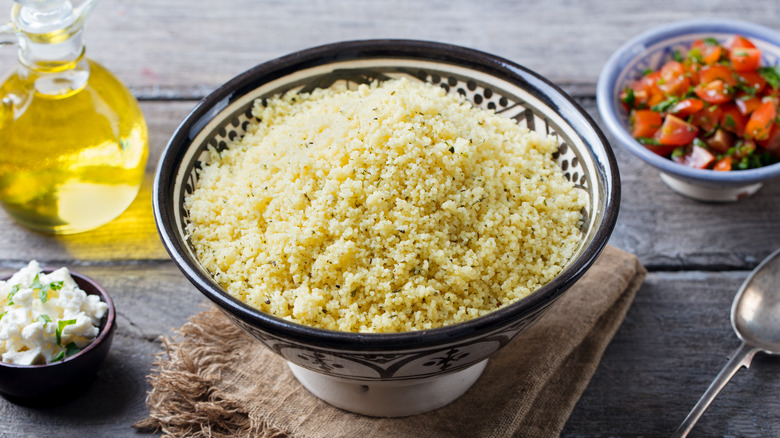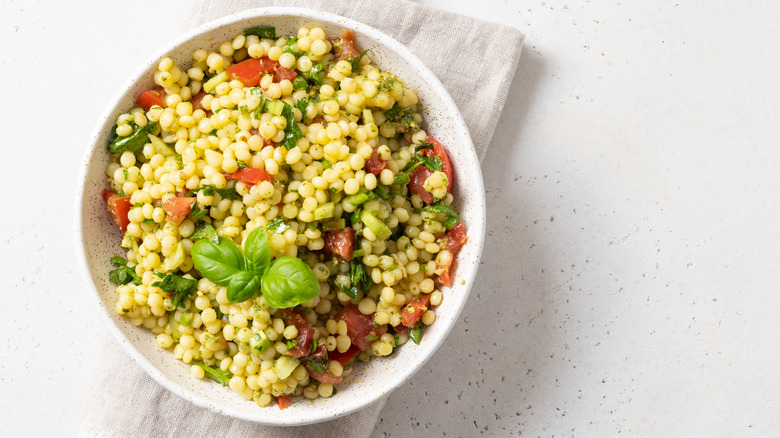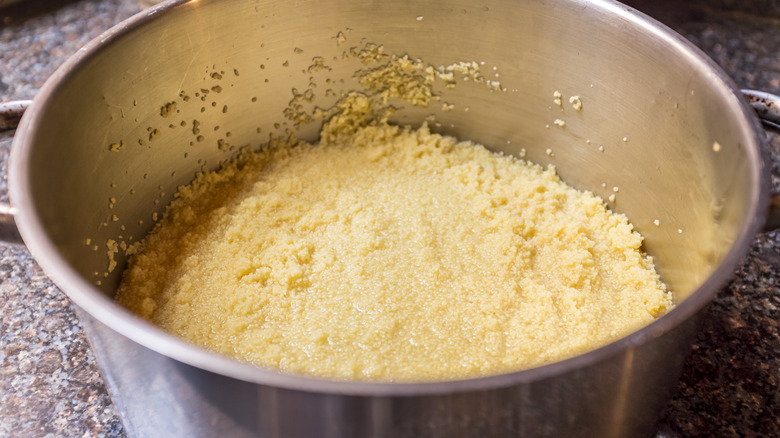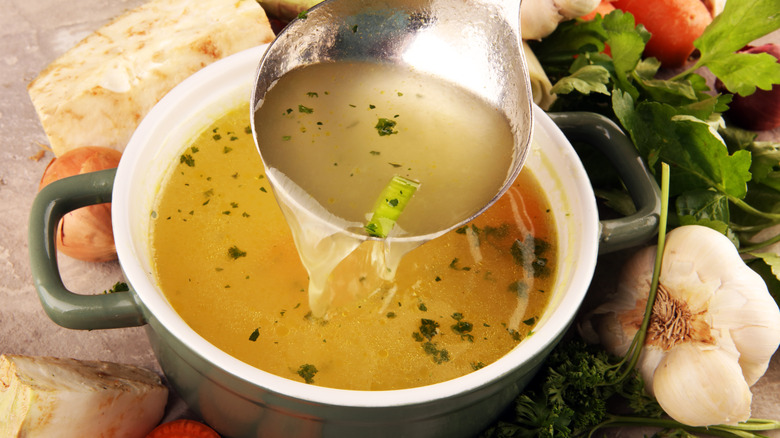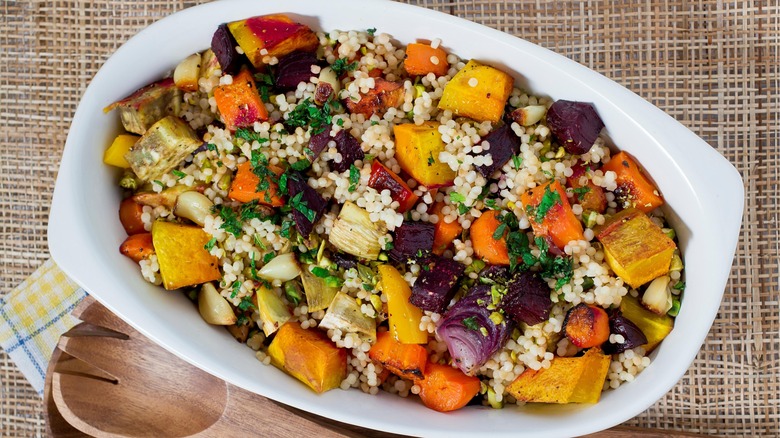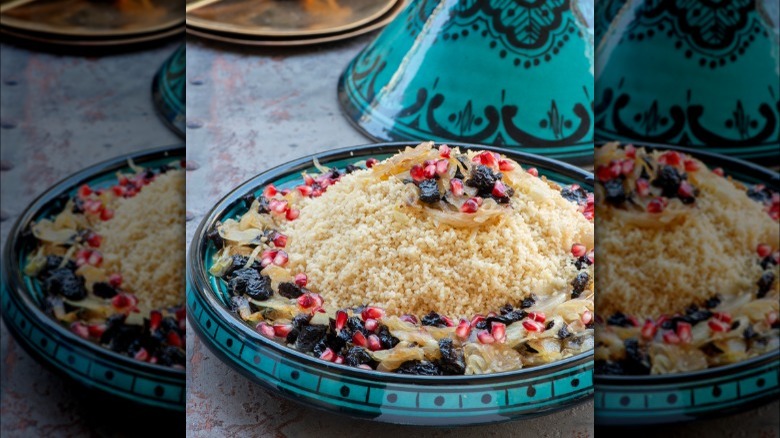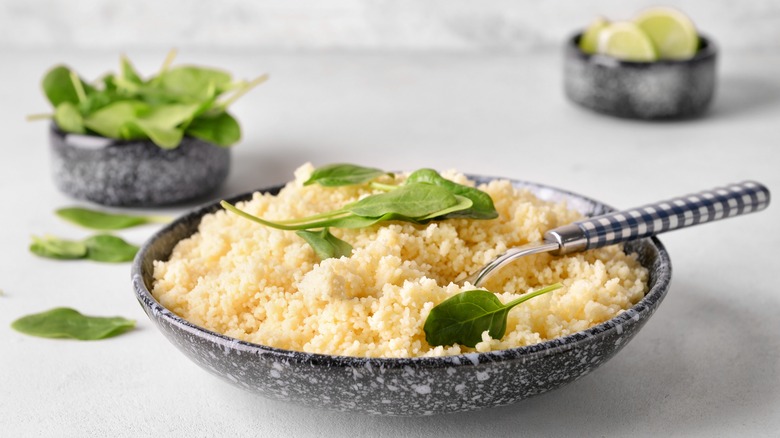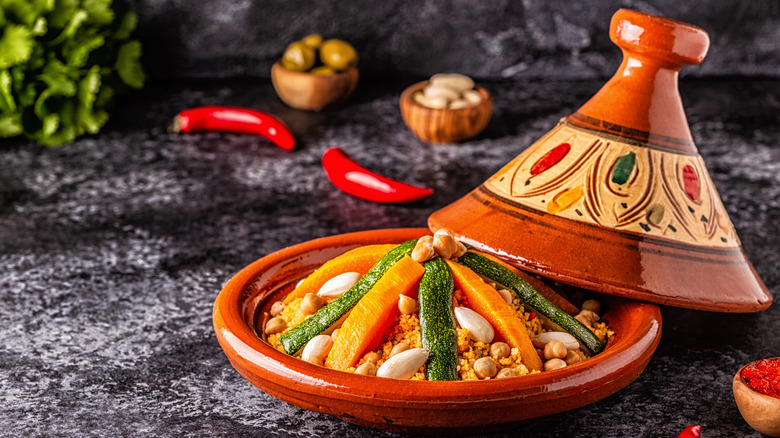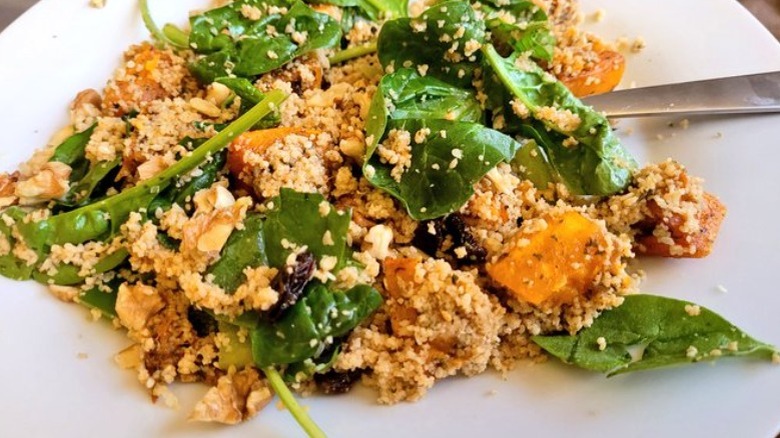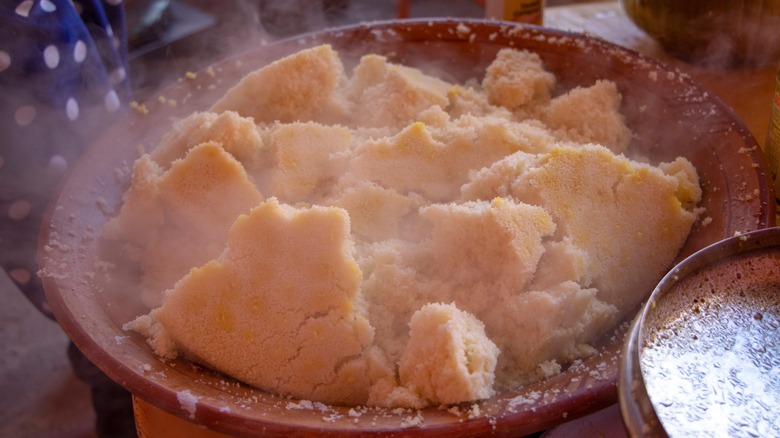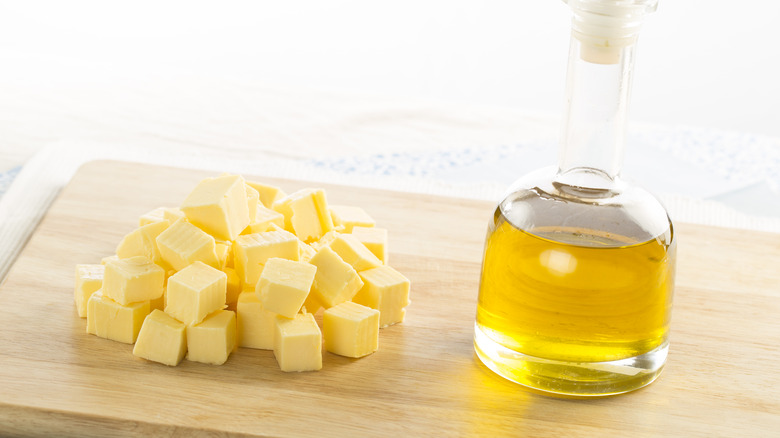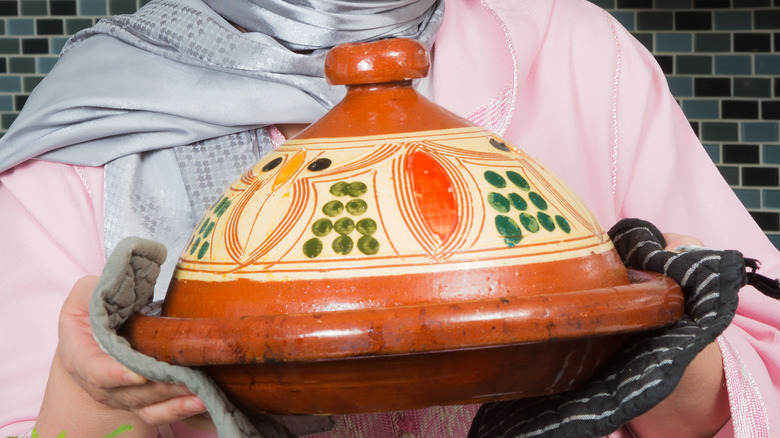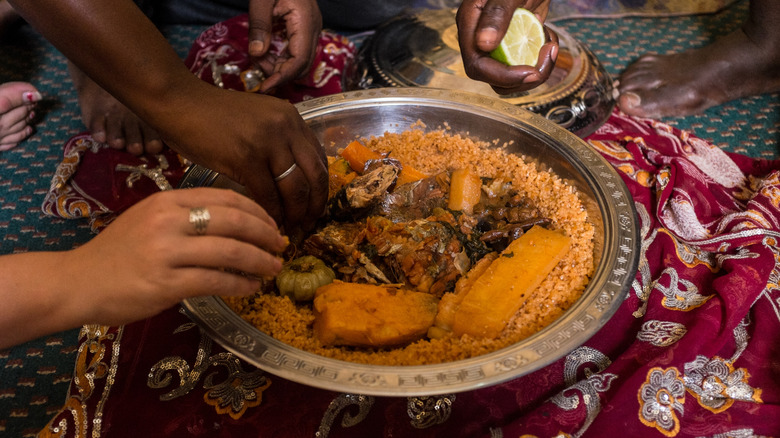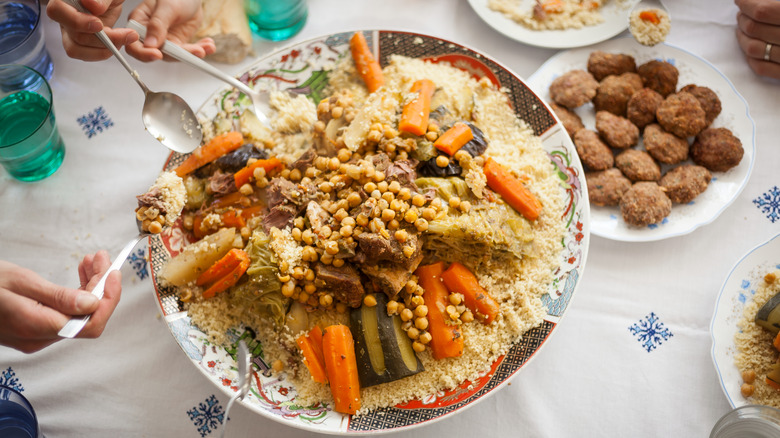Mistakes Everyone Makes When Making Couscous
Couscous is a delightful dish, as long as you don't make too many mistakes when cooking it. If you've ever ended up with clumpy couscous or just don't get the appeal, you're probably making it wrong. When done right, it's a dish worthy of sharing.
Couscous has been around for centuries. The earliest evidence we have for its existence comes from Northern Africa in the 3rd century. However, it first started appearing in Arabic cookbooks in the 1200s and 1300s. Morocco claims couscous officially belongs to them, but other North African countries like Algeria and Tunisia have also tried to lay claim to it. As a result of couscous spreading across northern Africa and into the Middle East, several varieties have developed over time. It's the differences between these various types of couscous that have led to many of the mistakes people make when making this grain. However, some of the mistakes result from not understanding what's involved in the fluffing process or how to serve the dish for optimal flavor and experiential pleasure. Read on to find out what all can go wrong, and what you can do to make sure you end up with fluffy, fragrant couscous every time.
Thinking every type of couscous is the same
Now that couscous has become more popular in the U.S., it's possible to find a variety of types in your local supermarket. While some come precooked and only need to rehydrate briefly with liquid, other types require steaming before eating. To determine which type you have, it's helpful to look at the packaging. If the grains are small and the instructions involve adding hot broth to the couscous and covering for a few minutes, you have the instant kind, which is much easier to prepare. Otherwise, the cooking process may be fairly involved.
Couscous comes in a variety of sizes. Moroccan couscous is a smaller-grained type of couscous that looks similar to grits in consistency. This is the fluffiest version of couscous. In other areas of north Africa like Algeria and outside Africa, couscous comes in balls of various sizes, which look like tapioca pearls. In Algeria, couscous is called berkoukes. Israeli couscous is called p'titim. Meanwhile, the largest version is Lebanese couscous (also called Moghrabieh), which is about the same size as the chickpeas you might add to the dish. Often, people refer to any ball-shaped couscous as "pearl couscous." However, technically, Lebanese couscous is true pearl couscous.
Using the wrong cooking method for your couscous
A common mistake people make with couscous is thinking every type is the same and requires the same cooking methods. Instant couscous rehydrates in mere minutes with the addition of hot broth. Raw Moroccan couscous should be steamed and fluffed. Meanwhile, pearl couscous should be boiled like pasta.
The easiest couscous is pre-cooked and simply requires adding hot liquid to rehydrate and plump the couscous. Instant brands you can find in the supermarket allow you to make the dish without the process being too elaborate or time-consuming. However, raw Moroccan couscous requires steaming, which can take up to five hours. In this method, you cook veggies and meat in broth below the couscous and allow the steam to cook the couscous, either using a dedicated couscoussier or steamer cookware. Most recipes involve two or three distinct steaming periods between which you should fluff the couscous. Some cooking methods include rinsing the couscous, salting, and adding oil or butter to help keep the couscous from sticking together.
Pearl couscous is large enough that you must boil it in water like regular pasta. So if you hear that you shouldn't boil couscous, that only applies to smaller-grained varieties. It's also worth noting that a practice some people incorporate when making couscous is to toast the couscous in a little oil or butter like you do when making risotto. This extra step adds a pleasant nutty flavor to the couscous that can elevate the dish.
Making it with a bland broth
One of the biggest couscous mistakes you can make is using a bland broth. Even worse, some cooks just use salty water like they would when making pasta. Couscous should be a flavorful dish, and if you're not using tasty broth, you're doing it wrong.
One of the most important components of your couscous is the broth. If you're making instant couscous or ball-shaped versions of couscous, it will permeate the grains. Otherwise, it makes a flavorful topping. The standard proportion of couscous to broth is 1 to 1. Some Moroccan cooks provide separate bowls of the broth in case some people want to add more to their portion of the couscous.
Onions and garlic always make a good base for any broth. If you're making Moroccan couscous, you'll want to use spices common to Moroccan cuisine, such as black pepper, saffron, cumin, ginger, and cinnamon. Fresh herbs like parsley and cilantro also suit many dishes. However, you could branch out to other flavor profiles like curry, or Italian herbs like basil and oregano.
Making the same type every time
There's no reason why you should get in a rut when it comes to making couscous. The easiest way to change couscous is to vary the seasonings you use in the broth. You can go for traditional Moroccan spices one time, your favorite curry another time, and more Mediterranean-inspired spices the next. However, changing up the type of couscous you use, the veggies, or the meat can also make a complete change in the flavor profile.
In the winter, you may go for winter squashes, cabbage, and more root vegetables like sweet potatoes, carrots, and parsnips. However, in warmer months, you can branch out into other seasonal ingredients from your garden, the grocery store, or the farmer's market, such as tomatoes, corn, zucchini, and fresh herbs. And if you're making pearl couscous, you could even add roasted veggies and fresh herbs over the top rather than boiling your veggies.
Beef, chicken, and pork all taste great with couscous. However, you should also make an effort to find lamb, which features in many Moroccan couscous recipes.
Forgetting to try it with raisins and other garnishes
One of the great pleasures of couscous is the extra garnishes you can add to bring it over the top. Dried fruits, nuts, and even pomegranate seeds can bring the flavor profile up a notch. Many people also serve couscous with a small dish of spicy Moroccan sauce called harissa on the side.
A particular favorite is to add raisins, which you'll find in many Moroccan couscous recipes. One of the signatures of Moroccan cuisine is encountering sweetness where you wouldn't expect it. When you cook raisins in with the broth during the final minutes, you'll end up with plumped, boiled raisins throughout your couscous. It makes a pleasant sweet contrast to the other savory ingredients. Brown raisins are great, but we've found golden raisins to be particularly good in couscous. However, there's no reason to stop at dried grapes. You can try out other dried fruits like dried barberries, cranberries, or apricots.
It's best to add nuts after cooking to add a nice texture to the dish.Try pine nuts, pistachios, or slivered almonds for added crunch, flavor, and protein, especially if you're making vegetarian couscous.
Boiling any couscous that's not ball-shaped
One of the mistakes that some people make when making Moroccan couscous is thinking that they're supposed to add water or broth and then boil it. However, that only works when you're making ball-shaped couscous. Algerian, Israeli, and Lebanese couscous are all closer to pasta, so they need boiling. However, you shouldn't boil Moroccan couscous. Finer-grained couscous is too delicate and can turn to mush if you boil it. You want all the grains of your couscous to be distinctive and separate and not a bowl of mush.
If you have pre-cooked instant couscous, you should be pouring liquid over the top, covering it, and allowing it to absorb the liquid rather than boiling it in the liquid. Raw couscous needs to be steamed rather than boiled. If you're not exactly sure which type of couscous you have, you should check the back of the package. The basic cooking instructions will give you a good idea about which type you have. If it tells you to add hot water on top of the couscous or steam it, you'll absolutely regret boiling it.
Not plating it properly
If you're making instant couscous, it can be tempting to just add all the ingredients and mix them together in the pot. Of course, it will taste just as good even if you're less artful about it. However, constructing your couscous layer by layer in a large dish turns it into more of an experience, no matter what type of couscous or cooking method you used.
In Morocco, the traditional dish for couscous is a large, round platter with a high lip. However, you can use a large casserole dish just as easily for the task. And if you're making a small amount you can even use a tagine. The nice thing about this traditional dish is that you can use the conical lid to cover instant couscous during the rehydration and steaming process.
You'll start out by adding a layer of couscous along the bottom. If you're using instant couscous, you'll add broth over the top and cover until it's hydrated. Then, if you're using meat, you'll want to pile it in the middle of the dish on top of the couscous. Some cooks like to make a small well in the middle for the meat. Now, you'll arrange the vegetables around the meat. If you've used large pieces of vegetables, it's common to make symmetrical arrangements.
Adding too much liquid to Morrocan couscous
Whether you're starting with raw or instant Moroccan couscous, there's definitely such a thing as adding too much liquid, which is a big mistake. You should be using equal parts liquid to grains. So, if you have 4 cups of couscous, 4 cups of liquid should do the trick. Adding more will leave you with a dish that's swimming in liquid, which isn't the goal. Couscous should be dry enough that you can form it into a small ball in your hand. If you can't, you've added too much liquid. And while you can always adjust later on, there's not much you can do if it gets too soupy.
If your grains do seem a little dry, add extra butter or olive oil instead. Oil also provides the bonus of keeping the couscous from sticking together, whether it's Moroccan or other couscous styles. Another option some cooks offer is to serve reserved liquid in an extra bowl on the side in case the dish is too dry for someone's liking or they want an extra infusion of flavor.
Not fluffing your couscous
Fluffing is an essential part of making Moroccan couscous. Fluffing is especially necessary when making raw couscous, and you'll do it after each steaming session. However, it is also vital to instant couscous texture. You'll want to do all your fluffing with warm or room-temperature couscous rather than cold couscous from the fridge because the cooler it gets, the more it clumps.
Some cooks use their fingers for the fluffing process, especially if they're making a feast-sized quantity. However, most of us will probably prefer fluffing piping-hot couscous with a fork. A spoon won't do because you can't really get in between the grains to prevent them from sticking together. Adding oil or butter before fluffing can also help keep all the grains separate with less overall clumping. If you added the right amount of liquid, and you're still having a problem with clumpy couscous, there's a good chance that you're not fluffing vigorously enough.
Not adding butter or oil
A common couscous mistake is not adding butter or oil, which is just as vital to the final texture as the cooking method and fluffing your couscous. During the fluffing process, melt a pat of butter or add a good glug of oil over your couscous. As you fluff, the fats will coat the grains of the couscous, making them stick together less, while also adding a delicious layer of flavor.
If you're making instant couscous, you can add butter or oil as a part of the rehydration process before you fluff. You can add the butter or oil directly to the broth or add it in a separate step before fluffing. If you're making traditional couscous using raw grains, you'll want to add the oil or butter after one of the steaming sessions before fluffing.
When choosing which type of fat to use, consider the overall flavor profile of the dish. Light olive oil and butter work well because they don't stand out above the other strong flavors of the dish. You may want to avoid a stronger-flavored oil like dark-colored extra virgin olive oil that can make the dish more bitter.
Not covering instant couscous and allowing it to sit before serving
Couscous is not a dish that wants to be hurried. Sure, instant couscous is quick and convenient. But you still have to make it the right way. Not only should you add liquid to rehydrate the couscous, but it's important that you cover the dish while the couscous is hydrating. A tagine is a perfect option for this step if you have one. By covering the dish, you are allowing the couscous not only a chance to rehydrate, but you are also slightly steaming the couscous as the hot liquid creates a warm and moist environment inside the container. This step is exactly like what you do when you allow stovetop rice to steam for a few minutes after cooking it.
If you're finding that your instant Moroccan couscous isn't soft enough or fluffy enough, it's possibly because you're skipping this vital step. If you don't cover the couscous after you steam or hydrate it and you find that it still seems crunchy or not moist enough, it's tempting to add more liquid, which is the wrong move. Instead, the right step may be to cover it and let it self-steam to perfection.
Not eating couscous with your hands
If you ever find yourself eating couscous in Morocco, your hosts may not provide you with a spoon or fork. There you will be, sitting around a large round dish of couscous piled high with meat and vegetables. However, may be no utensils in sight.
Eating couscous with your hands can be a little bewildering to the uninitiated, but it's a common way to eat couscous in Morocco. It's not unusual for a pitcher to come around the table for handwashing to ensure everyone is starting with clean hands. Then everyone digs into their section of the giant dish of couscous, enforcing imaginary lines of which section belongs to who. It's only polite to save licking your fingers until the end of the meal to keep the process as hygienic as possible. Sometimes you might get a spoon to help the process along.
If you've never experienced eating couscous with your hands, you're missing part of what makes the meal such a pleasure. So shuck off Western table manners for an evening and try it out the traditional way. If it turns out that it's not for you, you can always grab some utensils instead.
Eating it alone
Couscous is a meal that families eat together or that you will find at celebrations like weddings. Most Moroccan families even have a certain day of the week when they eat it: Fridays. It's one of those comfort dishes you can depend on to usher you into a relaxing weekend. However, you can also find some families who eat it throughout the week.
If you eat couscous the traditional way — layered in a large dish and eaten with your hands — it's just not nearly as fun alone. With both meat and a variety of veggies to dig in to, it will please almost everyone at the table. Couscous makes a fun dinner party dish. So invite your friends and family, hide the utensils, and enjoy. Of course, not everyone will be game to eat with their hands, but you can try. Whatever do you, don't forget to serve some refreshing Moroccan mint tea alongside it. After all, no meal in Morocco is complete without it.
